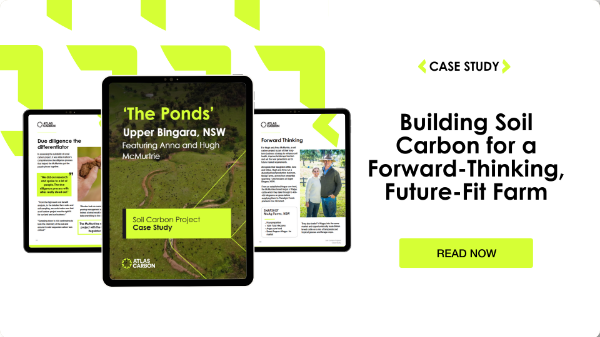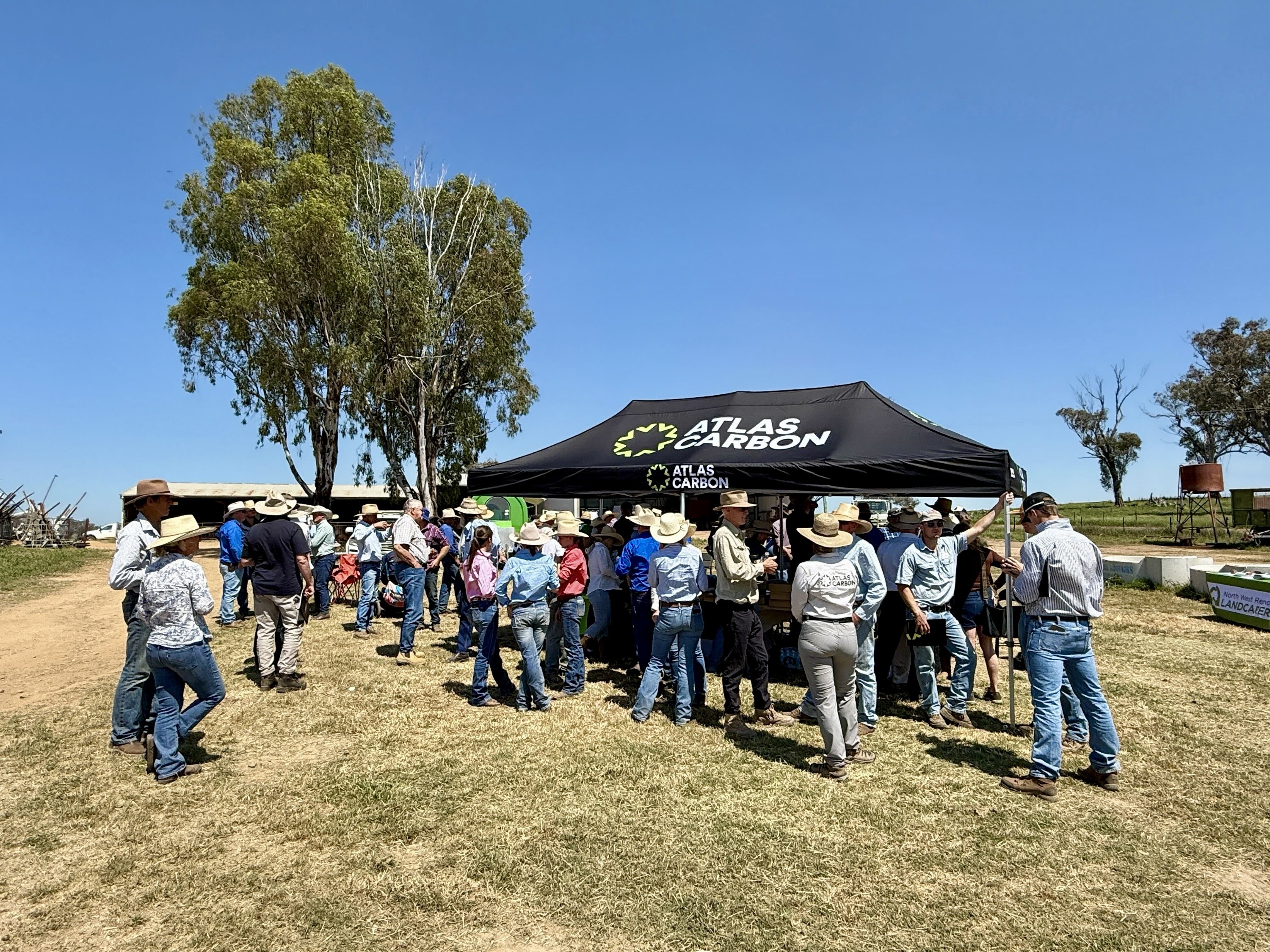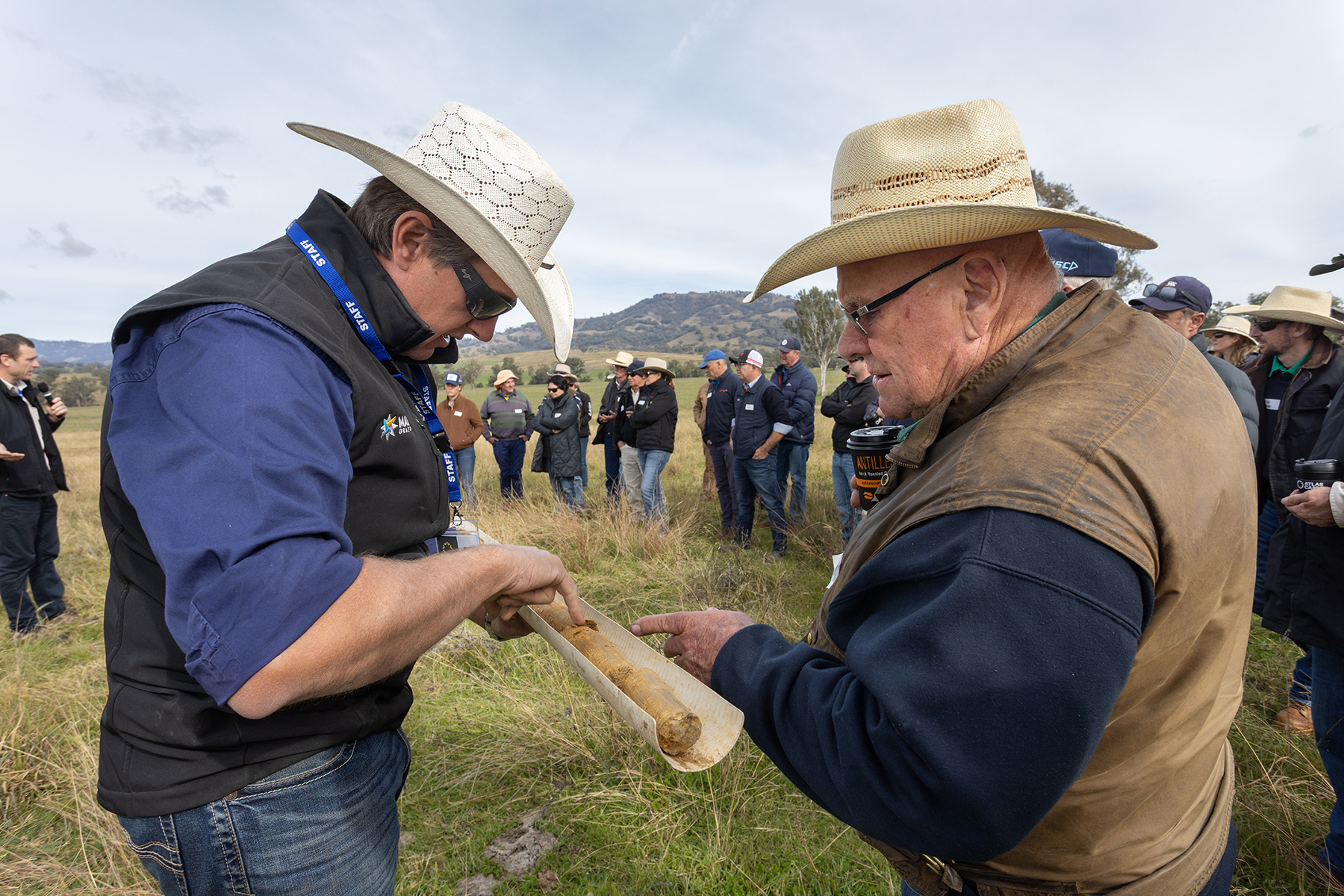Taking the time to visit farms and literally dig into the dirt is the best way to uncover the potential beneath a grazier's feet.
- A farm visit to Walkers Hill confirmed the property's potential for a carbon project through a crucial process of deep-dive soil analysis and core sampling.
- Physical examination of the soil showed exciting results, like roots reaching 80 cm deep, which signals a healthy system ready to tap into deeper water and nutrient stores.
- The key to increasing soil carbon comes down to smart grazing—strategies like Pulse Grazing and Optimising Stocking Density keep roots active and build a more resilient landscape.
Watch Emily's video diary to see an on-farm soil carbon project viability assessment in action or read her detailed blog entry below.
Digging into Soil Carbon at Walkers Hill
Recently, I had the opportunity to join our Pasture & Grazing Consultant, Rafe Ritchie, on a farm visit to assess a property for a soil carbon project. The farm visit is a critically important part of the due diligence we carry out with graziers who are considering a soil carbon project. Read along to learn about what we got up to as we set out to uncover the hidden potential beneath the Earth’s surface.
Meeting the People Behind Walkers Hill
With coffee in hand, we headed off for Walkers Hill to meet Brian and Ruth Allen. Their property, located north of Condobolin in Central West NSW, is a mixed livestock grazing operation with some opportunistic cereal cropping.
Ruth wears two hats - alongside managing the property, she’s also a Customer Success Specialist with MaiaGrazing. With her deep knowledge of graze planning, forecasting, and data-driven decision-making, she helps fellow graziers get the most out of their grazing enterprises.
For the past 13 years, Brian and Ruth have implemented dynamic, rotational grazing, carefully managing their land to improve soil and pasture health. Recently, they’ve been keeping a close eye on the emerging soil carbon opportunities and were eager to assess whether Walkers Hill could be suitable for a carbon project. Beyond that, they saw this as a chance to review their grazing strategies, discuss potential uplifts in production, and get a deeper understanding of their soil’s composition through sampling.
Mapping the Soil Story
Before heading into the paddock, we gathered around the dining room table - coffee in hand once again - to go over our soil sampling plan.
Prior to every farm visit, our team conducts a deep dive into soil mapping data, analysing different soil types, depths, and compositions. This allows us to identify distinct soil strata, essentially grouping similar soils across the property. The result? A rainbow-like map showcasing the diverse soil types at Walkers Hill. Our goal was to collect at least one soil core from each stratum to get a clear picture of the farm’s soil variations and its potential for carbon storage.
With the plan set, it was time to head out, get our hands dirty, and start sampling.
The Power Beneath Our Feet
Taking soil cores is a fascinating process, offering a rare glimpse into what’s happening beneath our feet. What struck me most was the variation in soil, not just across the property, but also down the core itself.
There’s something powerful about being able to see, feel, and smell the soil up to a metre deep. It gives us a greater appreciation for our resource base and a deeper understanding of what’s driving productivity underground.
Each soil core we examined told a story. We looked at colour, aggregation, smell, moisture levels, root presence, and composition. Rafe drew on his background and learnings to explain the impact of different soil properties on production and to help Brian & Ruth flesh out what the potential improvements could be. The four of us had some really valuable conversations, bouncing ideas off each other and springboarding ways to turn the dial on their management of the landscape.
One core we pulled up was particularly exciting—it had roots extending down to 80cm, a great indicator of a well-functioning soil system. As Rafe pointed out, in many cases, we’re only using the top 5–10cm of our soils. That begs the question:
What are we potentially missing out on here? Could we utilise nutrient and water stores deeper in our system?
When roots grow deeper, we’re tapping into the real potential of our soil, accessing more moisture and nutrients, and ultimately building a more resilient ecosystem.
Grazing Strategies That Build Carbon
While soil sampling was our focus, we also assessed pasture health, stocking density, and grazing strategies. To build carbon in our soils, we need to keep living roots in the ground for as long as possible. Every time we capture moisture and sunlight and stimulate a plant to grow, we extend the time those roots stay active - feeding microbes which shoot carbon into the soil.
Here’s a few key insights from our discussions:
- 80% of Grazes Done Right = Progress: Not every rotation will be perfect, but if 80% of your grazing decisions support soil health, you’re moving forward.
- Pulse Grazing for Stimulation & Rest: Allowing animals to stimulate plant growth with grazing, then giving pastures time to recover, is critical to build deep-rooted, perennial pastures.
- Optimise Density to Reduce Selective Grazing - increasing stock numbers, to roughly 250 DSE/ha for sheep or 20 head/ha for cattle, helps change livestock behaviour to increase pasture utilisation and promote even stimulation across our paddocks.
Brian and Ruth’s experience with their lucerne paddocks provided an interesting case study in pasture performance. While the total yield—measured in DSE Days per Hectare (DDH)—was slightly higher than their native pasture of a similar size, they found that the costs and side effects outweighed the benefits. The expense of sowing lucerne, combined with reduced ground cover, lower pasture diversity, and increased soil compaction, made it less viable in the long run.
Rafe described this using what he called the "Mars Bar Theory." Just as eating only Mars Bars would eventually make you feel sick, relying solely on lucerne can have negative effects on livestock. Animals, like people, need a diverse diet to stay healthy and perform at their best. This insight reinforced the importance of maintaining a mix of pasture species for resilience and productivity.
Final Thoughts—Why Farm Visits Matter
These farm visits aren’t just about soil samples. They’re about:
- Building strong relationships with producers
- Understanding their unique challenges
- Finding practical, data-driven solutions
The real reward? Helping farmers unlock their land’s full potential - whether that’s through better grazing management, soil health improvements, or exploring soil carbon opportunities.
My highlight of the day was holding those soil cores, feeling the different textures and compositions, it gives us a much richer understanding of the world beneath our feet. And, when we consider that our livelihoods depend on this soil, why don’t we do this more often? With a deeper knowledge of our underground ecosystems, could we run more resilient and productive operations?
These are the questions that drive us. Because when farmers understand their soil, they’re not just building better businesses - they’re creating landscapes that will thrive for generations to come.
Read our case study to learn why the McMurtrie's in Upper Bingara, NSW, have committed to building soil carbon
.png)
.png)

.png)
.png)


